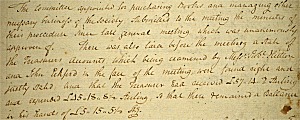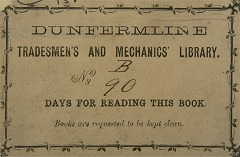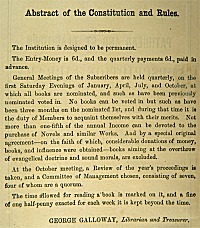Contents ![]() | Introduction
| Introduction ![]() | Institutes of learning
| Institutes of learning ![]()

Subscription libraries
Page 2 of 2 | Back
Dunfermline Subscription Library
Dunfermline was the home of the first subscription library that can be traced to in Fife. It was established on 26th February 1789. A share in the library at this date cost £3 and the annual subscription was 7/6 [37.5p]. The cost meant that only the most well to do in the community could afford to join.

Working class libraries
Subscription libraries fitted well with the Enlightenment's attitude towards and sympathy for mutual improvement. It became the philosophy that guided another wave of working class library foundation. This led to what has been called a 'large network of very small libraries, based on small communities'. The first opened in the lead-mining community of Leadhills in 1741. In the period 1790-1822 more than fifty were founded. They became common in rural towns. Dunfermline, Cupar, Kirkcaldy, Dalkeith, Newton, and Penicuik had this type of library by 1800 and Edinburgh had both Subscription and Select Subscription libraries. Most of these were middle class institutions. Members came from those who could pay to join and read.
Working class libraries needed members' subscriptions too. But fees were low. So they were often helped by contributions from some who had no intention of borrowing - the upper classes. Also, there were clear differences between middle and working class libraries. A study of surviving catalogues observed differences in stock. Those with middle class readers were much quicker to embrace fiction, which was not taken up until much later in the 19th century by working class libraries.

Library organisation
Usually, a committee was elected to run subscription libraries. Members paid a regular subscription, which covered costs like book purchase, accommodation fees, administration and the librarian's gratuity (if any). Book selection was either the work of a sub-committee or was dictated by the mass membership. The committee saw that a regular catalogue was purchased and the librarian (often paid a small retainer) was charged with collecting the books and auditing them annually.
Selection dominated by a single interest group was always a danger for these libraries. Another was ageing stock and so losing readers. Many people were capable of reading everything that interested them in a subscription library once they had done so they left, if new books did not keep up with their wants.
Page 2 of 2 | Back
In this section:
Circulating libraries | Subscription libraries | Itinerating libraries | Free public libraries
Contents ![]() | Introduction
| Introduction ![]() | Institutes of learning
| Institutes of learning ![]()